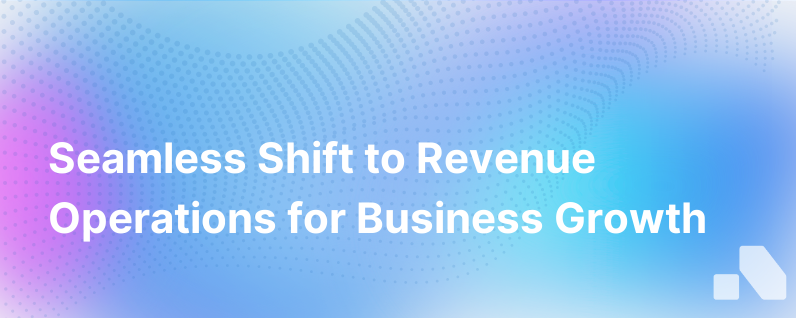
In the dynamic ecosystem of today's business environment, organizations are constantly seeking new methodologies to drive growth and streamline operations. Enter Revenue Operations (RevOps), an alignment amplification strategy gaining traction for its ability to break down siloes, synchronize processes, and ultimately, accelerate revenue growth.
The transition to Revenue Operations is not a mere shift in operations—it's a cultural metamorphosis aimed at unifying marketing, sales, and customer success. But why is this reinvention crucial, and how can businesses navigate this transformation effectively?
Let's explore the guiding principles, critical steps, and best practices for making the transition to Revenue Operations.
Understanding Revenue Operations
To comprehend the full spectrum of Revenue Operations, it's vital to recognize that RevOps is more than just a set of activities or an amalgamation of various departments. It's a strategic initiative that intertwines data, processes, and goals across the customer lifecycle to optimize the revenue engine of a company.
One of the transformative capabilities of RevOps lies in its potential to dismantle departmental barriers that often lead to disjointed customer experiences and inefficiencies. By synergizing teams that play a role in revenue generation, RevOps creates a streamlined funnel for lead conversion and customer retention. This internal alignment inevitably propels the business forward with one cohesive, focused vision.
Why Transition to Revenue Operations?
Enterprises that opt for a RevOps approach have witnessed significant enhancements in their operational efficiency, quicker decision-making, and refined customer journey mapping. When teams collaborate with shared metrics and common objectives, they:
- Drive operational efficiency through standardized, automated processes.
- Deliver a more coherent and satisfying customer experience.
- Make data-driven decisions with a unified data model.
- Align goals, accelerating revenue growth and shortening sales cycles.
The Pillars of Revenue Operations
RevOps stands on four foundational pillars: Strategy, Process, Data, and Technology. Each supports the overarching vision of revenue maximization.
- Strategy: RevOps strategy is about creating a roadmap that aligns how marketing, sales, and customer support work towards mutual revenue goals.
- Process: Processes within RevOps foster better workflow management by ensuring that every team knows its role in the revenue stream.
- Data: A data-driven culture is a cornerstone. Consistent and clear data enables accuracy in reporting, forecasting, and performance assessments.
- Technology: Tech stacks that are integrated and optimized eliminate redundancies and support a seamless transfer of information across the customer journey.
Transitioning to Revenue Operations: Step-by-Step
1. Assess and Align Objectives
The first, critical step is to evaluate each department's current objectives, metrics, and KPIs. Leadership must work together to realign these to serve the company's overarching revenue goals. These high-level objectives become the guideposts for the RevOps strategy.
2. Develop a Revenue Operations Team
Central to RevOps is a dedicated team, often led by a Chief Revenue Officer (CRO), tasked with overlooking revenue-generating operations across marketing, sales, and service. This team is responsible for strategy development, aligning tools and processes, and ensuring that unified data insights flow freely across departmental lines.
3. Harmonize Data and Processes
A unified data structure is at the heart of RevOps. Develop a single source of truth by integrating databases and CRM systems. Ensure that workflows and processes support uniform data entry and access, facilitating real-time analytics and forecasting.
4. Implement Integrated Technology Platforms
The technology stack underpinning RevOps should enable departments to work together seamlessly. Tools for automation, customer relationship management, and analytics should be interconnected, providing a holistic view of the revenue cycle.
5. Monitor, Optimize, and Scale
Post-transition, monitoring the performance of the RevOps model is crucial. Measure against pre-established benchmarks and utilize data-driven insights to refine processes and strategies continually.
Best Practices for Transitioning to Revenue Operations
Prioritize Communication and Transparency
As with any significant change management initiative, clear and continuous communication is essential. Be transparent about the benefits and changes with all stakeholders, and establish regular check-ins to facilitate open dialogue.
Cultivate a Culture of Collaboration
Foster an environment where cross-department collaboration is encouraged and rewarded. Educate each team about the others' contributions towards revenue growth to build empathy and understanding.
Upskill Your Team
As traditional roles evolve within the RevOps framework, it's important to invest in training. Equip your staff with the skills needed to adapt to tech-centric, data-informed, and process-driven workflows.
Leverage the Right Tools
Choose technology solutions that can adapt and scale with your RevOps ambitions. Prioritize platforms that emphasize integration, user-friendliness, and robust analytics.
Iterate and Optimize
The RevOps journey doesn't end with a one-time transition. It's an iterative process that adapts to changing market dynamics, customer needs, and organizational growth. Regularly reassess and optimize your strategies and tools.
A Path Forward with Revenue Operations
The journey towards a cohesive Revenue Operations model is both challenging and rewarding. By adhering to a strategic, systemic approach, businesses can unshackle the full potential of their revenue-generating teams.
Done successfully, RevOps not only streamlines processes but also infuses a dynamic, data-driven culture across the company's DNA. It's a galvanizing force that spearheads sustainable growth and a customer-centric approach to business.
As a B2B platform specializing in tools for strategic selling, Aomni recognizes the transformative power of Revenue Operations. With the ability to aggregate real-time account research, deliver actionable competitive insights, and create personalized sales content in minutes, Aomni complements the RevOps strategy, making the transition smoother and ensuring sustained success in the realm of revenue growth.